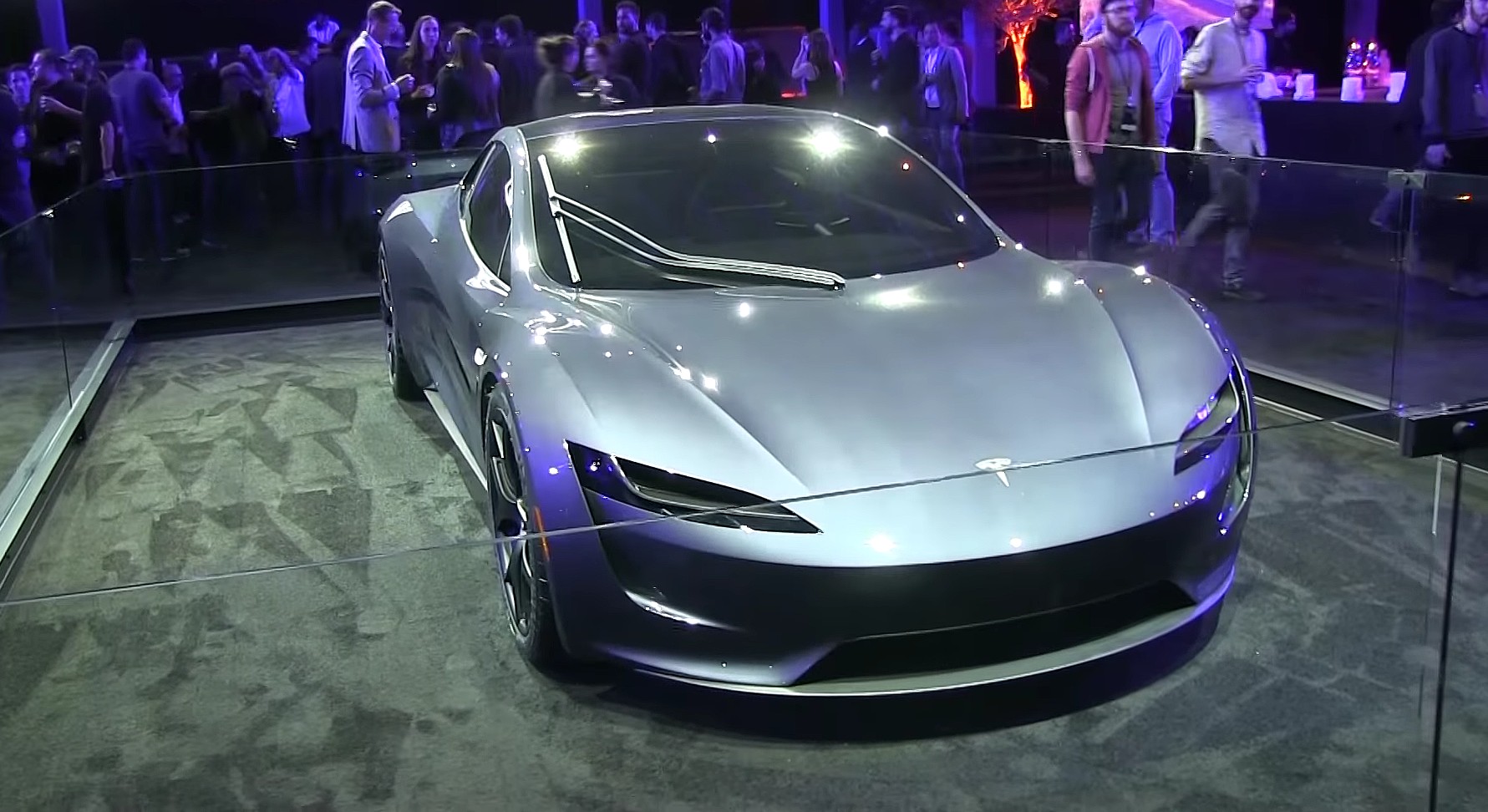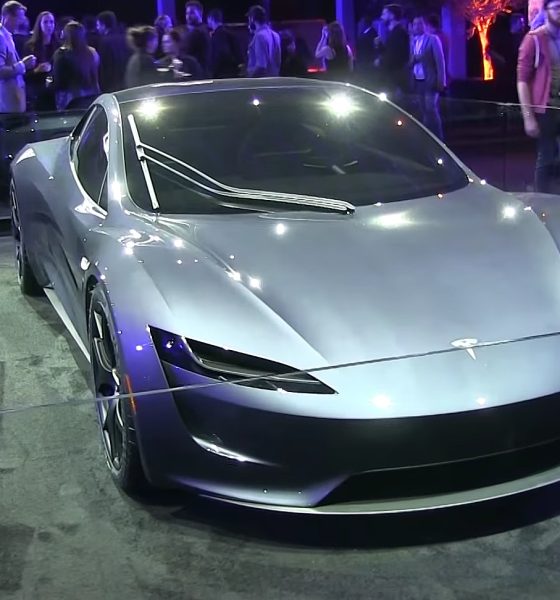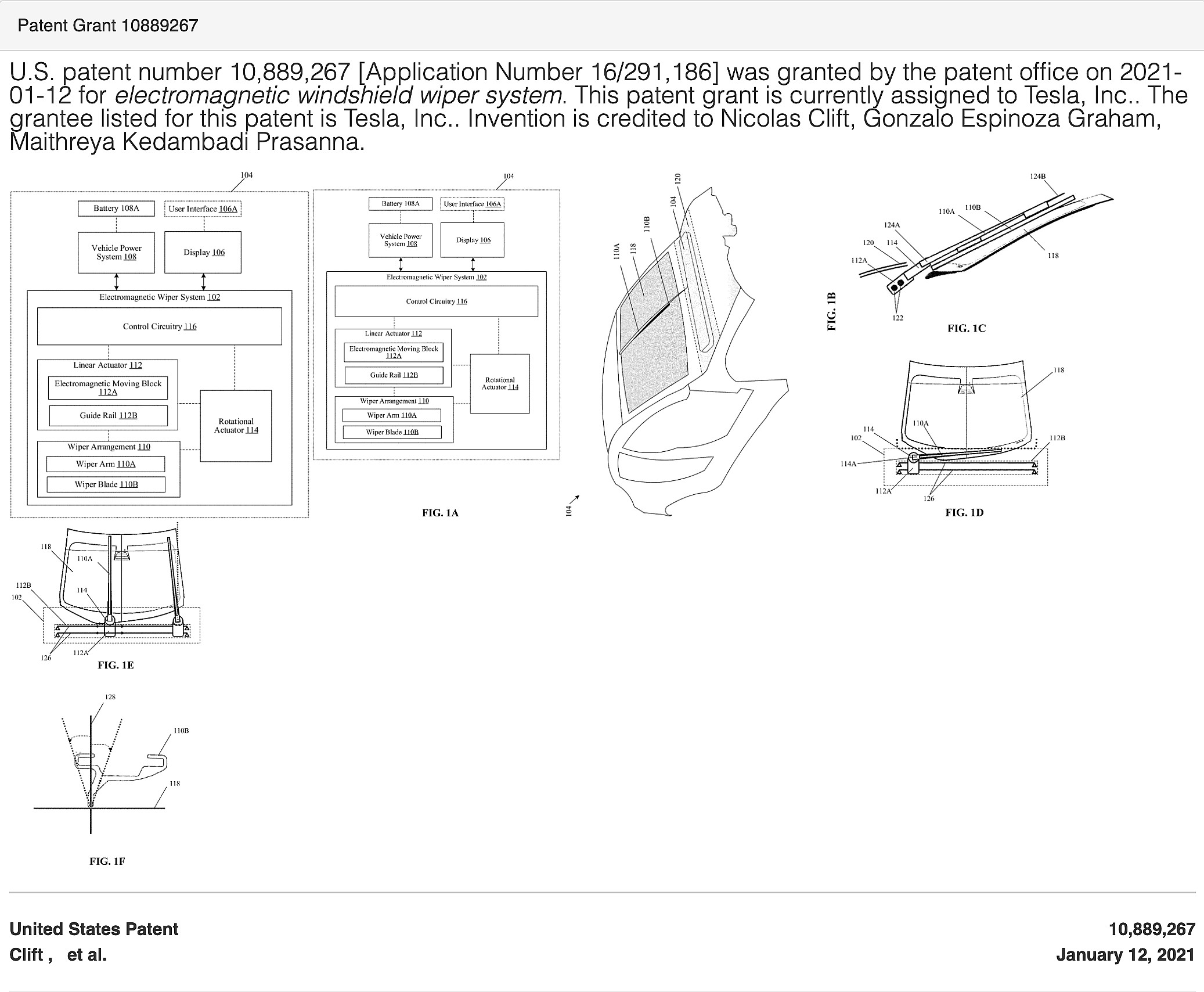

Lifestyle
Tesla Roadster’s revolutionary wiper design secures U.S. Patent approval
The United States Patent Office has approved Tesla’s revolutionary electromagnetic wiper design for the next-gen Roadster, documents show.
U.S. Patent Office documents reveal that patent number 10,889,267, the “electromagnetic windshield wiper design system” submitted by Tesla on March 5th, 2018, has been approved. Tesla published the patent over a year later on September 5th, 2019, and it was approved on January 12th, 2021.
Tesla’s Electromagnetic Wiper for the Roadster
Tesla’s patent shows a one-piece wiper design that is not typical or similar in any fashion to the “normal” two-piece windshield wiper architecture. Most vehicles, including all four of Tesla’s current lineup of cars, use two wipers that operate from the bottom of the windshield in an arc shape. This gives the driver coverage of the field of vision of the car they are operating, but it does not clear every raindrop from the surface of the glass. The top two corners, along with some other areas, are not affected by the traditional wiper design or range of motion.
However, Tesla wanted to install something slightly different onto its next-gen Roadster, which could be the fastest car to ever navigate on public roads. Instead of the traditional two-wiper blade design, Tesla’s patent details a one-piece wiper system that uses an electromagnetic linear actuator to rid the windshield of any rain or moisture completely. It will start from one side and move directly to the other side, cleaning the entire windshield with one motion.
The patent states:
“The disclosed electromagnetic wiper system may include a linear actuator that may include a guide rail and an electromagnetic moving block. The guide rail may include a plurality of permanent magnet bars that may be disposed horizontally along a curvature of the windshield of the vehicle. The electromagnetic moving block may act as an electromagnetic train, and may include a plurality of perforations and at least an electromagnetic coil that surrounds the plurality of perforations in the electromagnetic moving block. The linear motion of the electromagnetic moving block through the plurality of permanent magnet bars may be controlled to steer the wiper arm that may be coupled to the electromagnetic moving block, back and forth across the entire length of the windshield to wipe a defined region, for example, the entire transparent area (i.e., near cent percent area) of the windshield. This may result in minimal friction during the linear motion of the electromagnetic moving block.”
When the wiper blade is not being used, it will be hidden under the car’s hood. This adds to the Roadster’s clean and modern design, free of anything that could take away from its aerodynamically-advantageous design, including side-mirrors.
U.S. Patent Office Grants Approval
The United States Patent Office officially granted approval on January 12th, documents show.
“U.S. patent number 10,889,267 [Application Number 16/291,186] was granted by the patent office on 2021-01-12 for electromagnetic windshield wiper system. This patent grant is currently assigned to Tesla, Inc.. The grantee listed for this patent is Tesla, Inc.. Invention is credited to Nicolas Clift, Gonzalo Espinoza Graham, Maithreya Kedambadi Prasanna.”
Credit: United States Patent Office
Roadster Updates from Musk
Earlier this week, Tesla CEO Elon Musk gave some updates regarding the Roadster project, which has been delayed several times due to engineering modifications and battery constraints. Musk told Joe Rogan during his third appearance on the JRE Podcast that he wants the Roadster to hover and that he is still trying to figure out how to make that happen.
Musk said:
“I want it to hover. I’m trying to figure out how to make this thing hover, without, you know, killing people. I thought, maybe we could make it hover, but not too high. So maybe it could hover, like, a meter above the ground, or something. So, if you plummet, you blow out the suspension, but you’re not going to die. Maybe, I don’t know, six feet. If we put a height limit on it, it will probably be fine.”
Regardless of the Roadster will hover or not, Musk still plans to release a SpaceX package that will give three tons of thrust for insane acceleration. During the Q4 2020 Earnings Call, he also stated that production would likely begin next year.
Finishing engineering this year, production starts next year. Aiming to have release candidate design drivable late summer. Tri-motor drive system & advanced battery work were important precursors.
— Elon Musk (@elonmusk) January 28, 2021
H/t: @meckimac

Lifestyle
Tesla Model S Plaid battles China’s 1500 hp monster Nurburgring monster, with surprising results
There is just something about Tesla’s tuning and refinement that makes raw specs seem not as game-changing.

The Tesla Model S Plaid has been around for some time. Today, it is no longer the world’s quickest four-door electric sedan, nor is it the most powerful. As per a recent video from motoring YouTube channel Carwow, however, it seems like the Model S Plaid is still more than a match for some of its newer and more powerful rivals.
The monster from China
The Xiaomi SU7 Ultra is nothing short of a monster. Just like the Model S Plaid, it features three motors. It also has 1,548 hp and 1,770 Nm of torque. It’s All Wheel Drive and weighs a hefty 2,360 kg. The vehicle, which costs just about the equivalent of £55,000, has been recorded setting an insane 7:04.957 at the Nurburgring, surpassing the previous record held by the Porsche Taycan Turbo GT.
For all intents and purposes, the Model S Plaid looked outgunned in Carwow’s test. The Model S Plaid is no slouch with its three motors that produce 1,020 hp and 1,420 Nm of torque. It’s also a bit lighter at 2,190 kg despite its larger size. However, as the Carwow host pointed out, the Model S Plaid holds a 7:25.231 record in the Nurburgring. Compared to the Xiaomi SU7 Ultra’s record, the Model S Plaid’s lap time is notably slower.
Real-world tests
As could be seen in Carwow’s drag races, however, Tesla’s tech wizardry with the Model S Plaid is still hard to beat. The two vehicles competed in nine races, and the older Model S Plaid actually beat its newer, more powerful counterpart from China several times. At one point in the race, the Xiaomi SU7 Ultra hit its power limit due to its battery’s temperature, but the Model S Plaid was still going strong.
The Model S Plaid was first teased five years ago, in September 2020 during Tesla’s Battery Day. Since then, cars like the Lucid Air Sapphire and the Xiaomi SU7 Ultra have been released, surpassing its specs. But just like the Model Y ended up being the better all-rounder compared to the BYD Sealion 7 and the MG IM6, there is just something about Tesla’s tuning and refinement that makes raw specs seem not as game-changing.
Check out Carwow’s Model S Plaid vs Xiaomi SU7 drag race video below.
Lifestyle
500-mile test proves why Tesla Model Y still humiliates rivals in Europe
On paper, the BYD Sealion 7 and MG IM6 promised standout capabilities against the Model Y.

BYD is seeing a lot of momentum in Europe, so much so that mainstream media has taken every opportunity to argue that the Chinese automaker has beaten Tesla in the region. But while BYD sales this year in Europe are rising and Tesla’s registrations remain challenged, the raw capabilities of vehicles like the Model Y are difficult to deny.
This was highlighted in a 500-mile challenge by What Car? magazine, which showed that the new Tesla Model Y is more efficient, cheaper to run, and more reliable than rivals like the BYD Sealion 7, and even the nearly 400 KW-charging MG IM6.
Range and charging promises
On paper, the BYD Sealion 7 and MG IM6 promised standout capabilities against the Model Y. The Sealion 7 had more estimated range and the IM6 promised significantly faster charging. When faced with real-world conditions, however, it was still the Model Y that proved superior.
During the 500-mile test, the BYD nearly failed to reach a charging stop, arriving with less range than its display projected, as noted in a CarUp report. MG fared better, but its charging speeds never reached its promised nearly-400 kW charging speed. Tesla’s Model Y, by comparison, managed energy calculations precisely and arrived at each stop without issue.
Tesla leads in areas that matter
Charging times from 25% to 80% showed that the MG was the fastest at 17 minutes, while Tesla and BYD were close at 28 and 29 minutes, respectively. Overall efficiency and cost told a different story, however. The Model Y consumed 19.4 kWh per 100 km, compared to 22.2 for MG and 23.9 for BYD. Over the full trip, Tesla’s charging costs totaled just £82 thanks to its supercharger network, far below BYD’s £130 and MG’s £119.
What Car? Magazine’s testers concluded that despite BYD’s rapid sales growth and the MG IM6’s seriously impressive charging speeds, Tesla remains the more compelling real-world choice. The Model Y just offers stability, efficiency, and a proven charging infrastructure through its Supercharging network. And as per the magazine’s hosts, the Model Y is even the cheapest car to own among the three that were tested.
Watch What Car? Magazine’s 500-mile test in the video below.
Lifestyle
Tesla Cybertruck slapped with world’s least intimidating ticket, and it’s pure cringe
One cannot help but cringe and feel second-hand embarrassment at the idea of a person just driving around with a stack of these babies.

A Cybertruck parked at Stanford Shopping Center in California was recently hit with what might be the most try-hard piece of paper ever slipped under a wiper blade: a “fake citation” accusing the driver of supporting a “fascist car.”
The note, shared on X by Tesla staff program manager Ryan Torres, quickly made the rounds on X, where it quickly gained attention as an example of how not to protest.
The world’s least intimidating ticket
According to the citation, the supposed “violation” was “driving a fascist car.” The remedial action? Take the bus, call an Uber, or ride a bike. The note also dubbed Elon Musk a “chainsaw-wielding Nazi billionaire.” Now, protests against Tesla and Elon Musk have become commonplace this year, but one cannot help but cringe and feel second-hand embarrassment at the idea of a person just driving around with a stack of fake anti-Tesla/Musk citations.
Torres pointed out the irony himself in his post on X. Tesla currently employs over 140,000 Americans, and SpaceX has put the U.S. firmly back at the top of space technology. As Torres put it, maybe the person behind the world’s least intimidating ticket should “read a book on innovation before vandalizing” other people’s property.
Peak performative clownery
Not to mention that the fake ticket’s logic collapses under its own weight. EVs like the Cybertruck are literally designed to reduce emissions, not “destroy the economy.” If anything, Tesla has bolstered the United States’ economy by fueling jobs in engineering, manufacturing, and clean energy. It’s not the first time a Tesla has been the target of vandalism or politically charged notes, but this one stands out for sheer cringe value.
Torres summed it up neatly: “Peak clownery.” On that point, at least, the citation earns full marks. In a way, though, perhaps cringe fake tickets are not as bad as the literal firebombs that were being thrown at Tesla stores and cars earlier this year because some critics were gleefully misinformed about Elon Musk.








